The Steam bike is the iconic Steampunk form of transport, but in reality steam-powered bicycles have a long and honourable history, though they proved to be one of the more final dead-ends in the development of transport technology. (You could argue that anything with a motor must be a motorcycle, but the machines on this page are in most cases clearly constructed as bicycles with steam propulsion grafted on) Wikipedia gives a quick summary of steambike history.
The steam bicycle actually dates from 1868-69, before the invention of the Safety Bicycle, ie the configuration we ride around on today. This is not to be confused with what at the time would have been called an "ordinary" bicycle, which we know as a "penny-farthing". If you consider the injuries likely if you fell head-first over that enormous front wheel, almost any other configuration might be called "safety" by comparison. Edward Butler designed and built the first internal-combustion tricycle in 1884, while the first two-wheeled IC motorcycle was not built until 1885, by Gottlieb Daimler.
Interestingly, the two earliest exhibits here were both built in 1869. As is often the case in technological progess, it was an idea whose time had come. Well, sort of.
There is a 'List of motorcycles by type of engine' on Wikipedia, which makes fascinating reading, though the section on steambikes is rather short, with only eight entries.
The steam bicycle was never a practical means of transport, the problems of carrying enough water and the extra weight of a boiler being intractable; but people are still building steam bicycles and steambikes today.
The steambikes below are in roughly chronological order, but the applicable date is sometimes hard to determine.

The first steam tricycle, and the first true self-propelled land vehicle was built by Nicolas-Joseph Cugnot in France in 1769. It is well-known, and will not be described further here. It even still exists, kept in the Musee de Arts et Metier in Paris.

THE VOCIPEDRAISIAVAPORIANNA: 1818
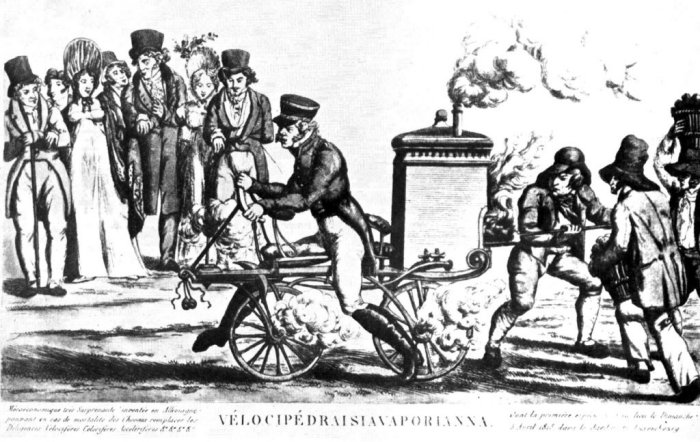 |
| Left: The Vocipedraisiavaporianna: 1818
It has to be said that the very existence of this machine is in doubt.
It has been suggested that the first steambike was a steam-powered draisine or hobby-horse, of which the unpowered version had been invented only two years earlier by Baron Karl Drais. It was said to be fitted with some kind of steam turbine on both front and back wheels, which would give it an excellent claim to be the first all-wheel-drive motorcycle. It was allegedly demonstrated in the Luxembourg Gardens in Paris on 5 April 1818.
The only 'steam turbines' available at the time were crude versions of the De Laval turbine, as used in steam jacks for turning roasting meat. Since these turbines have to turn at a very high speed (eg 30,000 rpm) to get any sort of efficiency, but here they were presumably coupled directly to the wheels, it seems unlikely that they were able to move the bike at all; certainly in the print the rider seems to be putting in some standard hobby-horse legwork.
On the other hand, there are details such as the two pet-cocks on the side of the boiler to control steam flow to each wheel, which suggest it was not purely a work of imagination.
The size of the boiler suggests that this machine would have been hopelessly top-heavy; the chimney also looks to be of an impracticably small diameter. Note that just to the right of it a burly fellow with a heavy frown is heaving a shovelful of coal into the furnace; just to his right a fellow in a very odd-looking hat is bringing up the next basket of coal.
The machine was allegedly called the 'Vocipedraisiavaporianna' which if nothing else is an impressive name.
|

THE MICHAUX-PERREAUX STEAM BICYCLE: 1869
 |
| Left: The Michaux-Perreaux steam bicycle.
This is normally considered to be not only the first steambike, but the first motorcycle of any kind. It was built in France, 1868-1869.
The engine is mounted at 45 degrees on the main frame member; behind it is the boiler, with what appear to be fuel and water tanks.
Note that this is a velocipede, not a Safety Bicycle, and the pedals are mounted directly on the front wheel. No brakes were fitted, which must have limited its practical use.
The Michaux-Perreaux steam bicycle now has a Wikipedia page.
|

THE ROPER STEAM BICYCLES: 1869/96
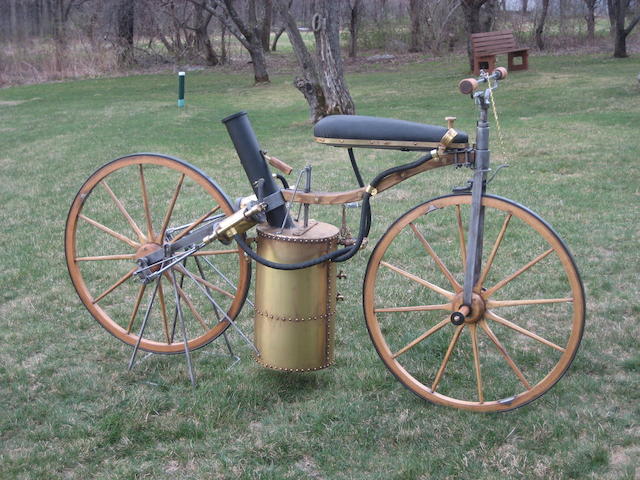 |
| Left: Replica of the early Roper steam bicycle: 1867
This steam-powered velocipede was built in 1869 by Sylvester H. Roper, of Massachusetts, and demonstrated by him at circuses and fairs. It had a vertical firetube boiler heated by charcoal.
This steambike had an oak and steel frame, and handcrafted ash wheels. The vertical fire-tube boiler was heated by charcoal.
The engine had one cylinder on each side, using the rear axle as a crankshaft. Piston valves were driven by return cranks on the outside of the main cranks. The seat, which doubled as a water-tank, is placed forward and the footpegs are extensions of the front axle. Not ideal for steering. The steam pressure gauge can be seen towards the front of the seat, connected by a rubber hose.
The original 1869 machine is preserved in the Smithsonian Motorcycle Collection in the USA.
|
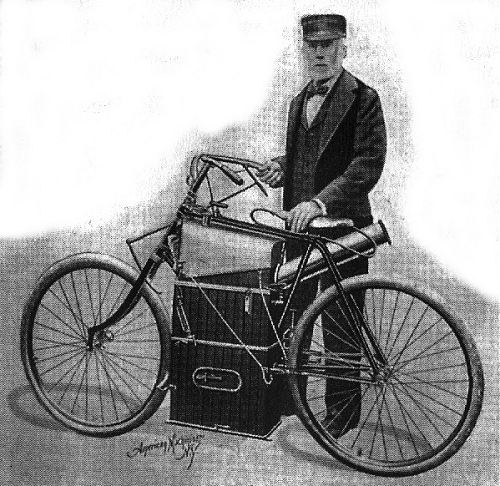 |
| Left: Sylvester Roper and his final steam bicycle: 1896
Roper's later steambike, with its rectangular boiler casing, is better known than the early version. The twin-cylinder engine has a cylinder bore of approx 2.25 inches. It directly drives 2.5 inch cranks on the right-hand side of the rear axle. The valvegear is of the piston type, actuated by eccentrics. A feed-water pump is driven by a crank on the left-hand side of the rear axle. The engine exhausts into the base of the chimney to provide draught, as in locomotive practice.
Roper died of a heart-attack on 1 June 1896, while driving this machine at 40 mph on a local bicycle track in Boston.
This design weighed 150 pounds ready to operate. It had to be restoked roughly every seven miles.
Note the spoon brake bearing on the top of the front tyre. These brakes were notoriously inefficient, and stopping the weight of boiler and engine must have been a tricky business.
|
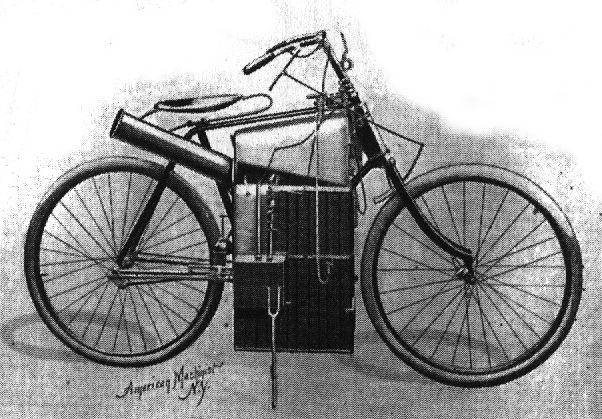 |
| Left: Another view of the Roper steam bicycle, from the other side.
This machine is in private ownership in the USA.
Several Roper replicas have been made. Here is one 1867 Roper replica, and here 1896 Roper replica
|

THE LONG STEAM-TRICYCLE: 1880
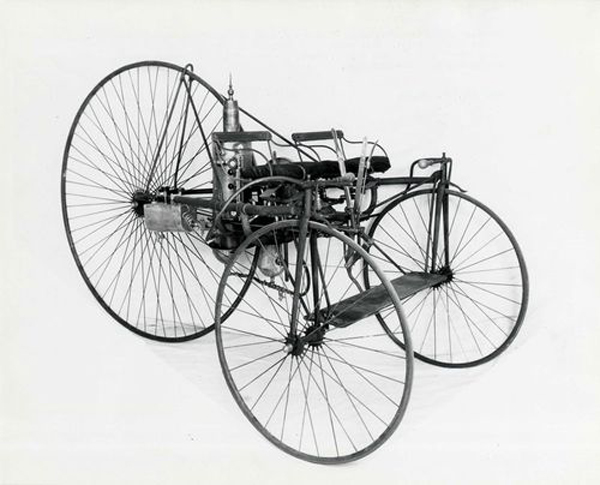 |
| Left: The Long steam tricycle: 1880
This steam tricycle was built in 1880, and patented in 1883, by George A Long, of Northfield, Mass. Allegedly his horse-owning neighbours were not happy with it puffing around on the roads, and Long dismantled it. The steam tricycle was reassembled by John Bacon; it is now in the Smithsonian Museum, and is said to be operable. Long lived until 1952.
The Long tricycle had a V-twin engine with 90-degree angle and a stroke of 15 inches. Total weight was 350 pounds.
The Long steam tricycle has a Wikipedia page, which gives details of the machine.
|
 |
| Left: The Long steam tricycle patent: 1883
This is one of two drawings in the 1883 patent. It shows the tricycle from above. The engine is to the left under the rider's seat; a pulley on its shaft drove the rear wheel by friction contact with the tyre. To the right of centre is a lever u that shifts between large and small pulleys, giving two gear ratios. The small diameter boiler j, seen from above, is on the centre-line between the engine and the change-speed lever u. According to the patent the fuel for the boiler was gasoline, delivered by air pressure.
This drawing seems to show a connecting rod between the two front wheels, despite the many comments on the machine that claim that the two wheels steered separately; that would hardly have been practical. Note that the tiller for each front wheel also includes a brake-lever for that wheel.
There are two tanks either side of the rear wheel. The one to the left is the 'condenser' though it seems ill-adapted to the role, having no fins and minimal surface area. The one to the right is the gasoline tank z', with filling funnel and air-pressure gauge. From the patent text:
"The fuel will be gasoline, to be delivered under the boiler from a holder, z', located opposite the condenser, in which it is to be supplied through the funnel a, provided with a cock, b', for closing it, and compressed air is to be employed for delivering the gasoline to the burner through pipe c, the air being pumped into the holder by hand with a pump, (not shown) to be worked by the
driver as required."
|
 |
| Left: The Long steam tricycle patent: 1883
This shows a side view of the tricycle. Note the very small diameter of the vertical boiler j.
The reservoir u (hanging under the engine, with a drain-cock at the bottom) had a rather obscure function. The patent text describes it as follows:
"Should the water not all be expanded into steam, it will escape into receiver u, located underneath the engines, from which it is to be discharged from time to time into said condenser, or into any tank where it will meet the water of condensation, to be pumped into the boiler again when sufficiently cooled. Thus much of the waste steam will be economized and the discharge of steam into the air will be avoided, the quantity of water to be carried will be diminished, and a material lessening of the load will be effected."
I'm not sure that makes any sense.
|
 |
| Left: The engine of the Long steam tricycle: 1880
This shows the inverted V-twin engine. The two forked connecting rods (with the piston-rods moving inside them) act on a single crank-pin. Judging by the shape of the valve-chests, piston valves were used; they are driven from two eccentrics on the crankshaft. No way of controlling steam cutoff appears to have been used.
At upper right the two friction wheels can be seen, with the larger one bearing on the tyre.
The steam pressure used is currently unknown.
|

THE VON SAUERBRONN-DAVIS VELOCIPEDE: 1883
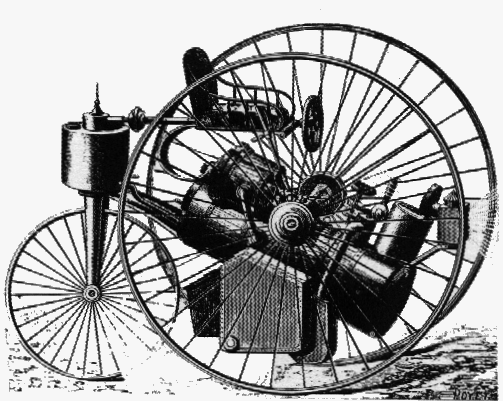 |
| Left: The von Sauerbronn-Davis steam velocipede of 1883.
If the size of this tricycle can be deduced from the size of the seat, it must have been a fearsome machine, with wheels about eight feet in diameter.
The boiler was petrol fired, which sounds rather dangerous, given that the rider was perched above the machinery. Note steering wheel in front of the seat.
I wholly accept that this is not a "bicycle" within the strictest of definitions, but it seems to belong here rather than on the Unusual Tricycles page. You may disagree. You may very well disagree.
No other image of this machine appears to exist.
|

THE COPELAND VELOCIPEDE: 1884
 |
| Left: The Copeland Velocipede
Lucius Day Copeland was a 19th-century engineer and inventor from Phoenix, Arizona who demonstrated one of the first motorcycles, a steam-powered high-wheeled bicycle, at the first Maricopa County Fair in 1884. The boiler is the vertical thing above the small wheel; the engine is slanted up towards the handlebars, with the crankshaft at the top. Final drive is by belt.
This machine could cover a mile in four minutes and was allegedly able to carry enough water to operate for an hour; in the absence of any sort of water tank that is a bit hard to believe. An example with the original engine is in the Phoenix Museum of History.
The Copeland now has a Wikipedia page.
For more information on the inventor see Lucius Copeland in Wikipedia.
|
Terry Wilson points out that this machine is not a 'penny-farthing' (ie having a large wheel at the front and a small one at the back) that has been reversed. The Star Safety bicycle with a small wheel at the front was invented by George Pressey in 1880. In an attempt to make a safer bicycle he altered the penny-farthing configuration so the small wheel was now in the front and doing the steering, while the rider sat above the rear drive wheel. This helped to combat the tendency of the penny-farthing to pitch the rider forward when encountering an obstacle. This act was known in cycling circles as a 'header', and could easily be fatal because of the great height. However, the small front wheel was skittish on loose surfaces such as sand and gravel.
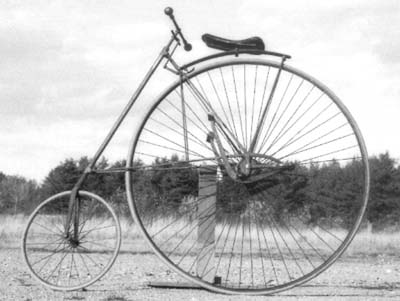 |
| Left: An unmodified Star bicycle
According to the original sales material, the Star had a performance advantage over the competition; with its ratchet-drive pedal system, a rider could achieve greater speed by operating both pedals at once, instead of the alternating method dictated by revolving cranks.
|
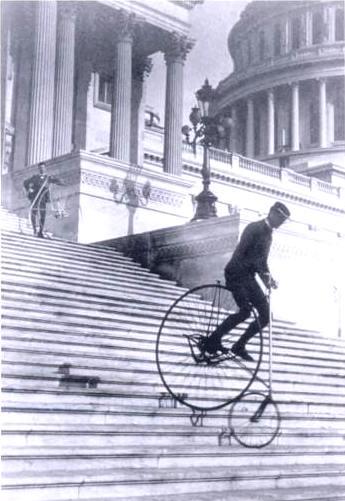 |
| Left: Demonstrating the stability of the Star bicycle
A famous photo of Will Robertson of the Washington Bicycle Club riding a Star down the steps of the United States Capitol in 1885. Danger, Will Robertson!
|

THE GENEVA STEAM-BIKE: 1896
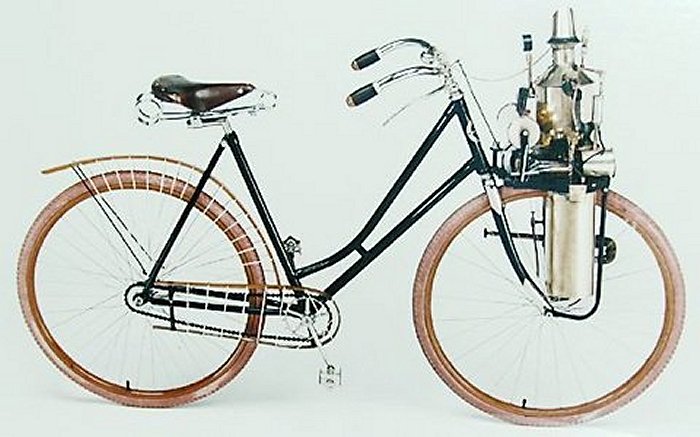 |
| Left: The Geneva Steam Bicycle: 1896
The Geneva Steam Bicycle was built by the Geneva Cycle Company of Geneva, Ohio, USA. Not the one in Switzerland.
It has a Wikipedia page but it has very little information beyond the steam plant being designed by Lucius Copeland (see just above) and the fuel was naptha.
This link gives some technical details and describes what it is like to ride.
In short, there is a copper boiler with vertical fire-tubes on one side of the front wheel; balancing the weight on the other side is a single-cylinder, double acting, slide-valve engine and a one-gallon water tank. Steam pressure was 100 - 120 psi. Drive is by a friction roller on the front wheel tyre.
This machine has been preserved.
|

THE STANLEY PACER: 1900
From around 1890, some racing and record-breaking cyclists made use of pacing, where a cyclist follows close behind a tandem (or some elaboration thereof) using the slipstream to reduce wind resistance and so increase speed. Tandems were faster than single-seat bikes because you got twice the power but about the same wind resistance. As speeds increased tandems became too slow and more riders were added; versions for three or four riders were called "triples" or "triplets", and "quads" or "quadruplets". Eventually five riders were used and the machines were called "quints", "quintiles", or "quintuplets". Pacing tandems etc were ridden by professionals; clearly you need a lot of highly-trained people if each pacing machine needs five of them. Sometimes as many as a hundred of them were under contract. For races between 50 and 100 miles each competitor would use six to eight pacing teams; it must have been an expensive business.
It became clear that quintuplets were about as far as you could go with this technology, and as speeds increased they became inadequate. Steambikes were the answer- or at any rate one answer. Internal combustion engines on the road were just getting started, but the electric tandem (here's one) made an effective alternative. Eventually IC engines took over.
 |
| Left: The Stanley Pacer: 1900
This is believed to be the steam tandem bicycle built by the Stanley brothers for the famous bicycle racer Eddie McDuffee. When paced by the Stanley steambike he set up a new machine-paced mile record of 1 minute 32 seconds in June 1899 at the Buttonwood track in New Bedford, Massachusetts. McDuffee supplied a $100 tandem frame to the Stanleys, who installed on it a boiler and steam engine.
The boiler can be seen in the centre of the frame, with an angled chimney that was supposed to exhaust over the left shoulder of the rear man. There are four vertical cylinder that probably held the petrol fuel, and what looks like a large triangular tank for water at the front.
This photograph probably shows McDuffee and the two Stanleys, but this is not so far confirmed.
|
 |
| Left: The Stanley Pacer: 1900
After the Stanley twins sold their steam-carriage business in 1899, the design of the steam pacing bike became the property of Locomobile.
Locomobile offered the Stanley-designed Model 6 in their 1900 catalog; it had two 14" Stanley boilers, the chimneys being inside the housing just above. Possibly the oddest thing about it was that it had to be operated by a team of two- the front man or "steersman" did the steering only, while the mechanic or "stoker" at the rear was kept busy handling the throttle, brakes, and all the burner and boiler controls. Obviously excellent co-ordination was required, and if this failed a spectacular crash was inevitable.
The vertical engine can be seen just behind the rear boiler and ahead of the forward fuel tank.
It is not clear if any of these machines were actually built or sold.
|
 |
| Left: The pacing system: 1901
The tandem here is not a steambike, clearly having an IC engine, but it does give some insight into the peculiar practice of 'pacing'. The rear man on the tandem sits upright, but leaning back slightly, to divert air around the racer on the left, who is keeping as close as possible- I doubt if this sort of proximity was practical in an actual race rather than a posed photograph.
The front man in the tandem is bent over to reduce his wind resistance, but given the drag from the upright rear man, it a reasonably powerful engine would have been required to keep ahead of the racer.
Given that both tandem riders also have pedals, it seems likely that the engine power available was actually marginal.
|
THE STANLEY LOCOCYCLE: 1902
 |
| Left: The 1902 Stanley LocoCycle: 1902
The LocoCycle was bult by the Stanley brothers. You can see it on YouTube from the 6:10 point, driving around at a very respectable speed.
The bike uses a Locomobile Mason engine with two cylinders of 2.5inch bore and 3.5inch stroke. The steam ia at 450 psi and superheated. The bike is geared for 50 mph at 500 rpm.
The owner, Bill Barnes, said in 2010: "I've driven it at least 25 miles and am waiting for plates so I can get on the main road."
|
THE D'ESPUJELO STEAM MOTORCYCLE: 1904
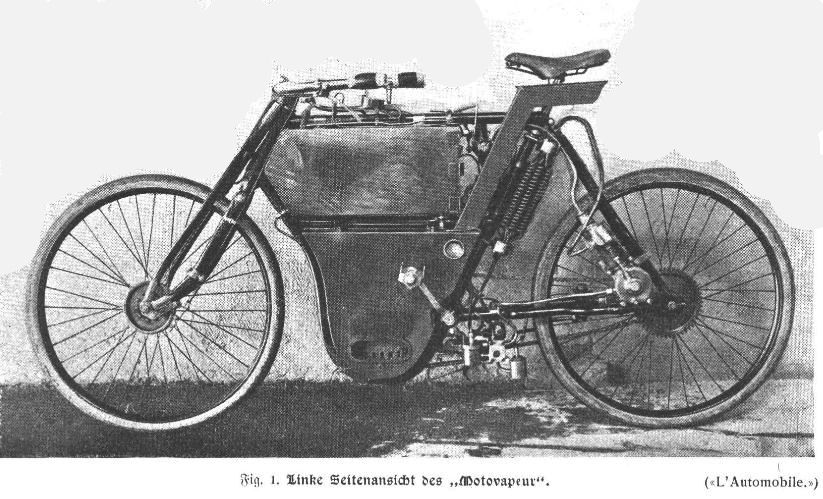 |
| Left: The D'Espujelo Steam Motorcycle: 1904
This steam motorcycle was built and ran around the streets of Paris in 1904. It was built by R D D'Espujelo, who is sadly unknown to Google. D'Espujelo doesn't sound like a French name to me; it may be Spanish.
The engine (apparently single-cylinder) is above and to the left of the rear axle. The article text says it has 'direct gear engagement to the transmission', which presumably means one stage of reduction by spur gears.
The caption reads: Fig 1 Left side view of the "Motovapeur". (L'Automobile)
Source: Allgemeine Automobil-Zeitung (General Automobile Newspaper) for 14 February 1904. Apparently reproduced from the french journal L'Automobile.
Thanks to Steven McDonald for drawing this machine to my attention.
|
 |
| Left: The D'Espujelo Steam Motorcycle: 1904
The water and petrol tanks are at the top, above the boiler. The exhaust flue can be seen just underneath the saddle. Below that is a spiral thing that is the condenser; it does not look big enough.
The article gives the steam pressure as '1kg', which if it means 1kg/cm2 is only 14.2 psi, which seems much too low. 10kg/cm2 (=141psi) seems a lot more likely.
The caption reads: Fig 2 Right side view of the "Motovapeur". (L'Automobile)
|
Here is the text from Allgemeine Automobil-Zeitung done into english (not by me) and it reads a little rough. Bear in mind that it has been translsted from french into german and then into english.
For 'moonshine' read condensate.
"An apostle of the "steam engine" has also arisen for motor-engined two-wheelers; he is named R. L. D'Espujelo, lives in Paris, and tells us in a letter that he often drives his new steam engine through the streets of Paris and is experiencing a sensation. "I have," the letter says, "a few
I have received a number of orders, which I have, however, turned down because I lack the capital to carry them out. However, I will establish a company that will implement my ideas, not only for motorized two-wheelers, but also for three-wheelers, four-wheelers, and carriages, not to mention the motorboats. As for the steam motorcycle itself, we will give a detailed technical description to L'Automobile.
Figures 1 and 2 show the steam-engined two-wheeler from both sides. Figure 3 shows the arrangement of the engine components as seen above. From the steam generator, the details of which are described below, the steam flows directly to the two throttle valves next to the saddle. One is driven by the valve stem, operated by a lever similar to the brakes; the other serves to release or lock the steam intake and thus regulate the speed. From here, the steam is fed to the engine, which has direct gear engagement with the transmission. The engine is attached to one side of the drive wheel on the winter wheel fork.
The most important data about this engine, which represents a very small opening, is: bore 34 mm, diameter 59 mm, normal speed 850 rpm, maximum Speed ??1300 rpm, maximum rotor power 2 HP at 40 kg pressure.
The exhaust steam from the engine flows into the air condenser, which can be seen as a bundle of spiral coils under the saddle, and ensures, on the one hand, good moonshine condensation and, on the other hand, consistent cooling of the moonshine. The air, whose cool temperature never exceeds 65°C, flows back into a cylindrical vessel located in front of and below and behind the pedal bearing. This vessel represents a simple container. The pressure coming from the engine condenser and the pressure required by the pump collects the backflowing water. In addition, a valve is provided for the occasional discharge of unfilled steam. Here, the water is automatically directed to the feed pump (in Fig. 2 and 3 along the inner horizontal fork), which is controlled by a valve mounted on the valve body as a counter nut. Before the water is drawn from the pump, it flows through a filter, which cleans it of boiler oil. The water level is kept as constant as possible by a float projecting from the water inlet from the reservoir. By means of a wall-adjustable valve on the reservoir, the manufacturer can change the amount of water flowing into the steam generator. The water and petroleum reservoir are located directly below the upper, sealed hub. The in the oil tank is transferred through a wall mounted at the front of the handlebar, just above the front fork.
The patented steam generator is housed in the housing beneath the water and petrol tank. It is suitable for a wide variety of steam engines, but especially for propelling two-wheeled vehicles due to its low weight. Its operating surface is relatively large. It consists of a series of double rod rotors, each of which has two concentrating cylinders, through which the water is guided. The steam
in the space between the inner and outer combustion chamber, which is now separated by a series of walls. All that is known about the burner is that it is fed with lamp paraffin or heavy oil, which is heated to a pressure of approximately 1 kg.
The first start-up of the steam engine only takes four to five minutes. The fuel is heated by means of a pressure washer. As mentioned, the engine acts on the rear wheel via a spur gear. The manufacturer can use the retarder to slow down the engine, but not to accelerate.
The weight of the meter-long two-wheeler, ready for use, is 48 kg. The fuel reservoir holds 2.3 liters of petroleum, while the petrol tank holds 5.3 liters. The petrol consumption is about 2.5 liters per 100 km."
|
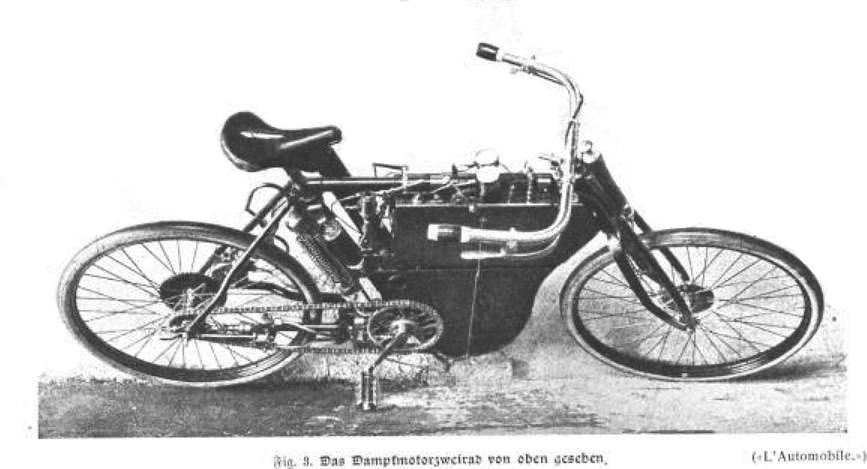 |
| Left: The D'Espujelo Steam Motorcycle: 1904
The motorcycle seen from above.
The caption reads: Fig. 3. The steam engine two-wheeler seen from above (L'Automobile.)
|

THE FIELD STEAM-BIKE: 1908
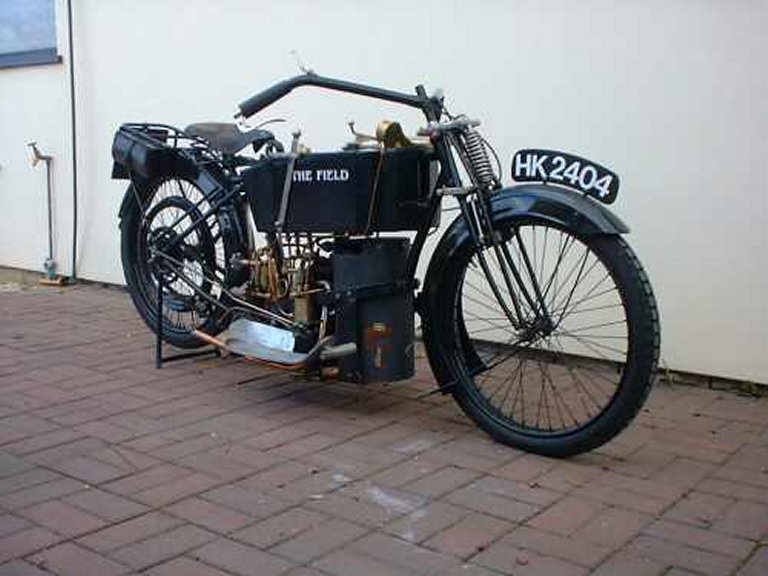 |
| Left: The Field Steam Bicycle: 1908
Only two steambikes were built by Field- this one pictured here is the earlier 1908 Mk1 model. A Mk2 was built in 1934. Much information about both bikes can be found at the steamcar.net website
The boiler is the black cylinder just behind the front wheel; behind that is the engine.
The cylinder dimensions are 45mm bore with 50mm stroke. It uses variable expansion with poppet valves; a variable-lift sliding camshaft was operated from the top of the tank. The engine developed 8 HP, and had a 180º crank shaft. The engine has cast iron pistons, Babbit-metal big end and bronze main bearings. It all sounds like quite sophisticated steam technology.
There is an amusing account of the starting procedure for a Field steambike at steamcar.net. I particularly like Step 5: "Stand back and let someone else light the methylated tray". (To pre-heat the petrol vapouriser)
There is an impressive video of a 1934 Field steambike being ridden on the Wall of Death, trailing twin streams of exhaust steam. I'm not making this up, go and look.
And he does it without a helmet.
The Field steambike has no Wikipedia page. Attempts to find out anything about Mr Field have not so far prospered.
|

THE PEARSON & COX STEAM-BIKE: 1912
 |
| Left: The Pearson & Cox Steam Bicycle: 1912
This steambike developed 3 HP.
Henry Pearson and Percy Cox were apprentices at the General Engine and Boiler Company of London. They began experiments, and by 1912 they were offering steambikes for sale to the public. This lasted only for two years when, as in 1914, Percy Cox sold his steambike manufacturing rights to the Steam Cycle and Motor Company of St Michael’s Road, Croydon. From 1908 to 1916, the company was primarily involved in the design and production of steam cars and the steambike was just a sideline.
Pearson and Cox have a Wikipedia page.
One of these machines, built in 1912 and shown here, is in the Science Museum in London. Their page on the machine states that "The arrangement of this motorcycle is similar to the Serpollet steam car, but it is simplified by the elimination of the condenser and much of the automatic mechanism." However, what is that just behind the front wheel? Looks like a condenser to me...
|

THE GILLENWATERS STEAM-FLYER: 1912
 |
| Left: The Gillenwaters Steam Flyer: 1912
The 1912 Steam Flyer, built by a Mr Gillenwaters in Sacramento; the name is often given as Gilligan but Gillenwaters is correct.
This machine is currently in the Musée Mécanique in San Francisco. It looks much more like a "steam motorcycle" than a bicycle with a steam-engine bolted on)
A placard near the Flyer claims that it was the first motorcycle built in the USA; this is not true.
|

THE HALESON STEAM BICYCLE: 1914
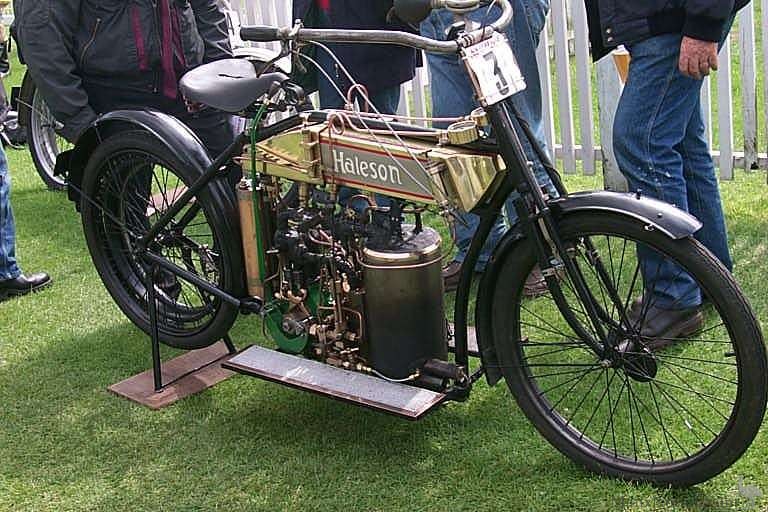 |
| Left: The Haleson Steam Bicycle: 1914
This neat-looking steam-bike was built by an engineer, Mr William Hale of Hanham, Bristol, in 1914. The Haleson was a conventional motorcycle produced from 1903.
In 1914, a special steam-powered version was built. It has a flash boiler- the fat vertical cylinder at the front- fired by paraffin, the steam driving a 200cc single-cylinder engine with side-valves. Drive from the engine was by belt with no need for clutch or gearbox due to the inherent flexibility of a steam engine.
There is a good video of the Haleson going at a respectable speed on YouTube.
This machine is claimed to be the only known steam-powered motorcycle in the world capable of running on a regular basis; I think Mr Hudspith (see below) might have something to say about that.
|
 |
| Left: The Haleson Steam Bicycle: 1914
There is not much technical detail available on the Haleson. Here the engine is behind the green plate; there is a flywheel on the other side.
There are two tanks, one in the usual motorcycle petrol-tank position, and the other on the rear carrier. Presumably they hold fuel and water, but which holds which is unknown.
If anyone has any more information, I would be very happy to receive it.
|
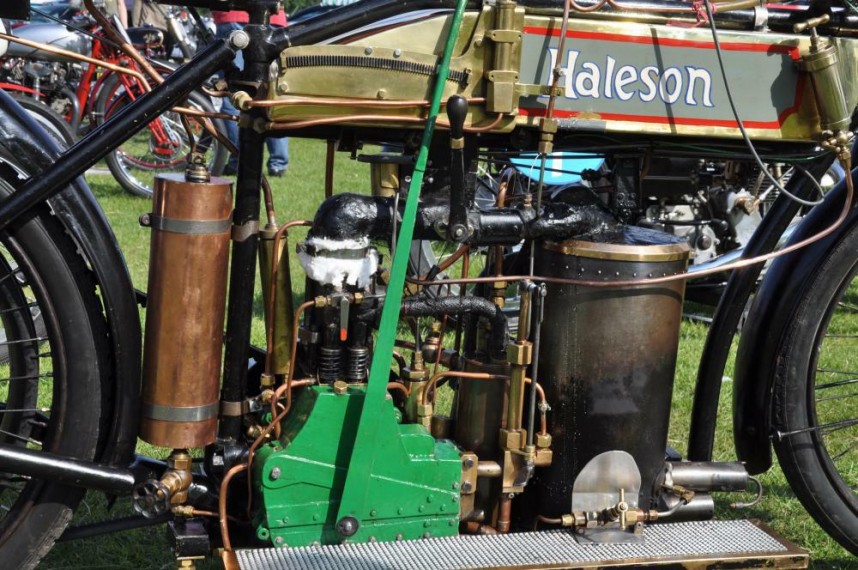 |
| Left: The Haleson Steam Bicycle: 1914
The black steam-pipe runs from the top of the boiler to the top of the engine. Half-way along it is the throttle valve, worked by a small black lever.
The purpose of the long green lever is unknown, but given that it seems to move over a multi-notched track, it can be set with some precision. I suspect it may control the engine cutoff.
The pump-like thing at top right is a manual lubricator for the engine.
The function of the vertical copper cylinder at left is unknown.
|
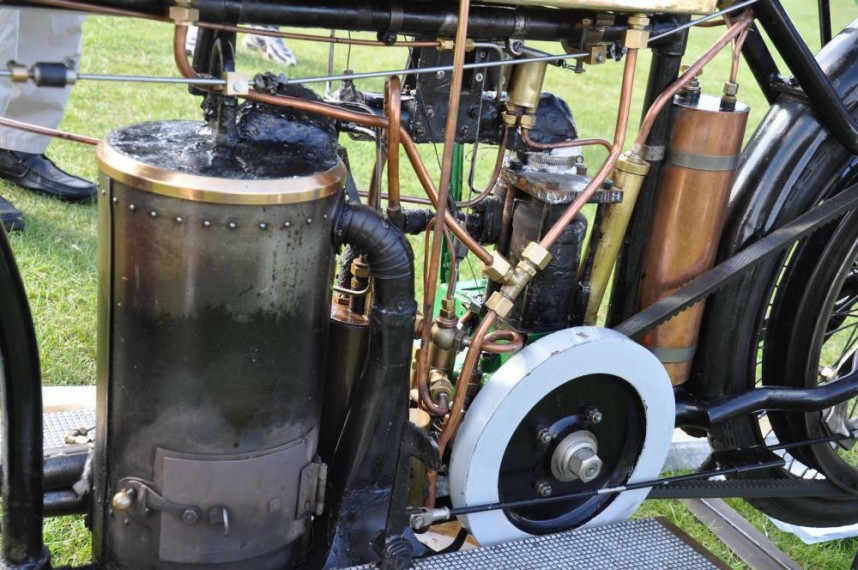 |
| Left: The Haleson Steam Bicycle: 1914
Here you can see a mystery brass cylinder next to the copper cylinder.
|
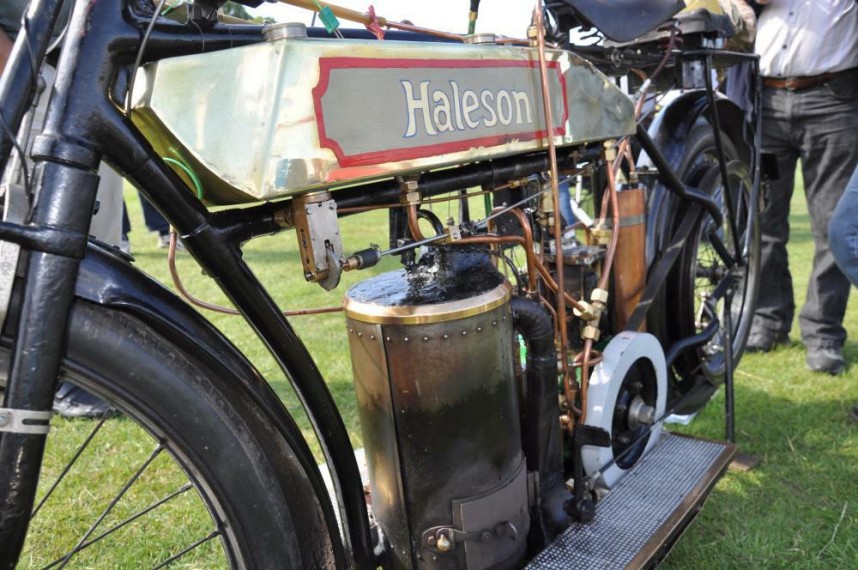 |
| Left: The Haleson Steam Bicycle: 1914
|

UNKNOWN STEAMBIKE: 1936
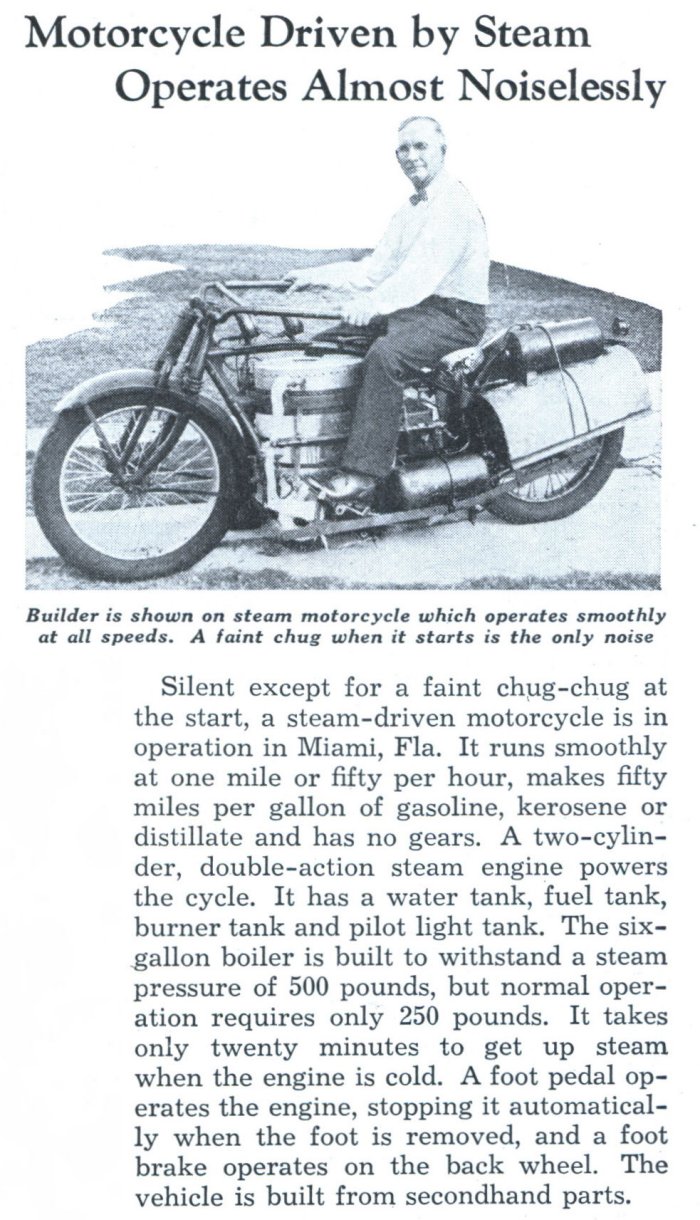 |
| Left: Unknown Steambike: 1936
This machine follows several others in that the boiler is a fat vertical cylinder at the front of the frame. It looks a bit like the 1902 Stanley LocoCycle or the 1914 Haleson.
From Modern Mechanix May 1936
|

THE RAY CLIFT STEAMBIKE: 1947
 |
| Left: Ray Clift Steam Powered Motorcycle: 1947
This is the Ray Clift Steambike, built in 1947. Here the boiler is not fitted. There was a cylinder (believed to be double-acting) on each side of the bike. Cylinder size is estimated at 2.5 in bore and 4 in stroke.
There is more info here, and also here.
|
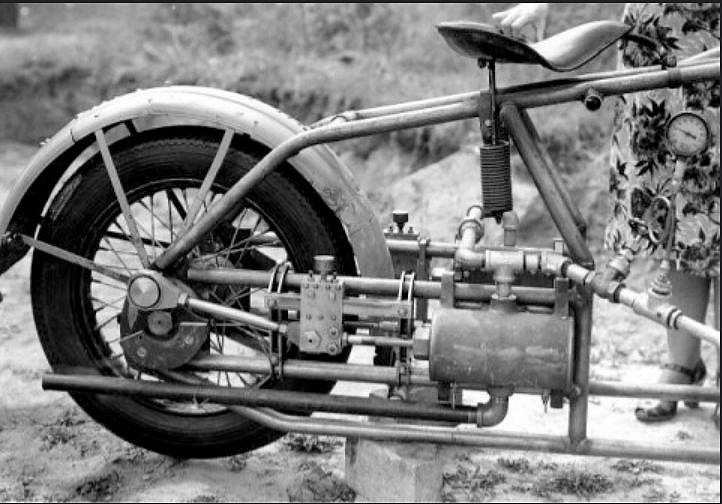 |
| Left: Ray Clift Steam Powered Motorcycle: 1947
The bike still exists and was housed in the National Motorcycle Museum in Anamosa, Iowa, where it was mislabelled as having been made in 1934. This museum closed in 2023 and the current whereabouts of the bike are unknown.
No boiler is installed here; steam is supplied by the pipe at the right. Note steam pressure gauge at extreme right.
|
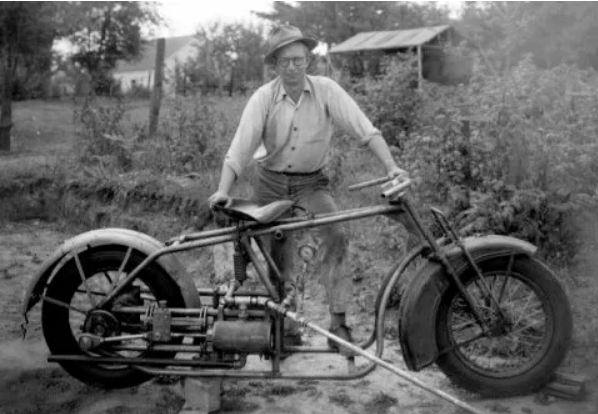 |
| Left: Ray Clift Steam Powered Motorcycle: 1947
This, I assume, is Ray Clift with his machine.
There seems to be plenty of room in the frame for a sizable boiler.
|
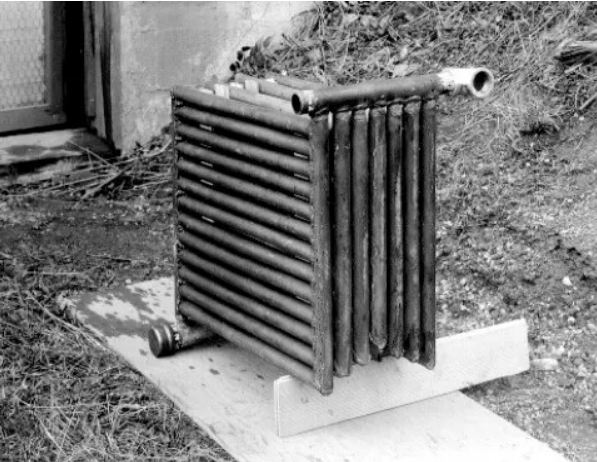 |
| Left: Ray Clift Steam Powered Motorcycle: 1947
This is the water-tube boiler. Its operating pressure is currently unknown.
|
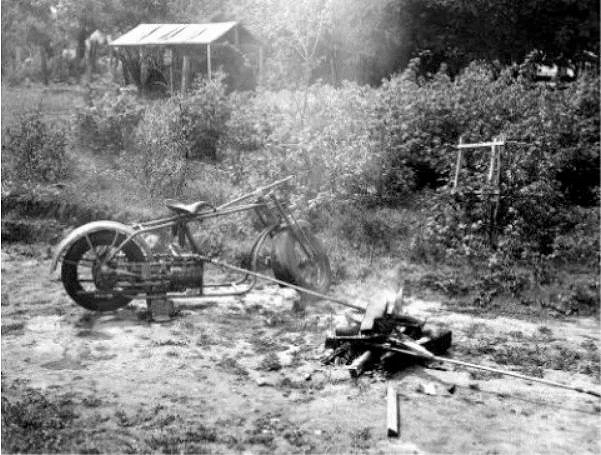 |
| Left: Ray Clift Steam Powered Motorcycle: 1947
A wider view of the test set-up. The steam pipe coming in at the right is presumably fed by a boiler out of shot.
However what's odd here is that the steam-pipe appears to zig-zag through a camp fire on its way to the steambike. Is this some sort of attempt at primitive superheating? All the piping seems unlagged and I would have thought that ought to have had the priority.
|


THE HUBBARD STEAMBIKE: 1970
The Hubbard steambike was custom built by Arthur "Bud" Hubbard of Monroe, Connecticut, during the early 1970's. He was following a two-part article published in The Model Engineer and Electrician for April 1918.
It looks like a solid and well-designed piece of construction.
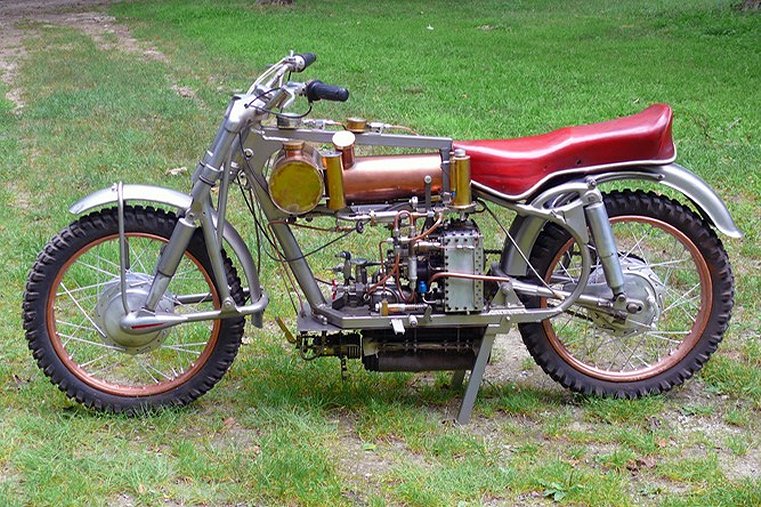 |
| Left: Steam Powered Motorcycle
The bike has a two cylinder, single-acting steam engine of 3 cubic inch displacement per cylinder; the crankcase is the silver box visible in the picture. Its calculated power is 6 HP.
Cutoff is variable from 0.2 to 0.8 of the stroke.
The transmission is direct drive (no gearbox or clutch) by roller chain.
The flash boiler has triple evaporation coils with a superheating loop.
Operating pressure is 400-700 psi superheated.
The burner is of the vaporiser type. The vaporisation coil is heated by alcohol for starting.
The motorcycle frame is a 1956 Maico from east Germany.
There is a web page on its restoration here.
It would be fascinating to see the plans, but so far a copy of The Model Engineer and Electrician for April 1918 has not been located. Searching is not aided by the magazine changing its name from The Model Engineer and Amateur Electrician to the shorter version sometime between 1902 and 1904.
|

THE HUDSPITH STEAM BICYCLE: 2000
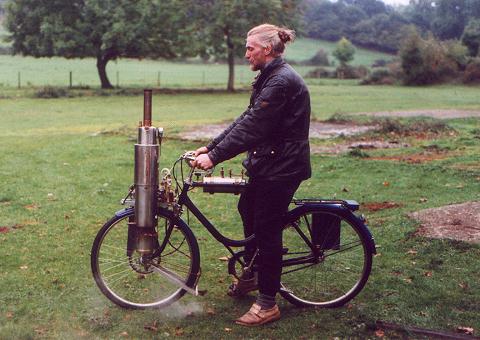 |
| Left: The Hudspith Steam Bicycle with steam up
This magnificent machine was built by Geoff Hudspith, shown mounted on it. It first ran in October 2000, though the original concept goes back to 1972. It was first demonstrated at The Great Dorset Steam Fair. (29th August - 2nd September 2001)
The boiler is fired by paraffin and steam pressure was initially 100 psi, raised to 125 psi in 2005.
There is an excellent YouTube video, and now a Wikipedia page.
For much more information see: The Hudspith Steam Bicycle (external link)
The Hudspith steambike has long had an honoured place on this page. There are however many more contemporary steambikes, and some of them, found by random Googling, are shown below.
|

GENE'S STEAM POWERED MOTORCYCLE: 2009
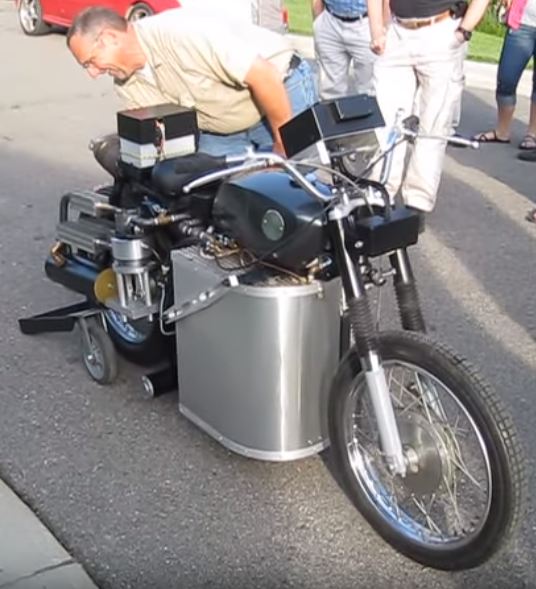 |
| Left: Gene's Steam Powered Motorcycle 2009
This machine is known to the Museum only as 'Gene's Steam Powered Motorcycle'. There is a
YouTube video of the machine at the June 2009 GoTech meeting at Ann Arbor, MI. There is much preparation, but the bike does not actually run in the video.
The bike makes extensive use of electronic controls. Nonetheless it is necessary to pump in the water by turning the rear wheel by hand, so some sophistication is lacking.
Nothing else is known at present; not even Gene's surname. If anyone can contribute further knowledge it would be much appreciated.
|

THE MELCHERS STEAM BICYCLE: 2009
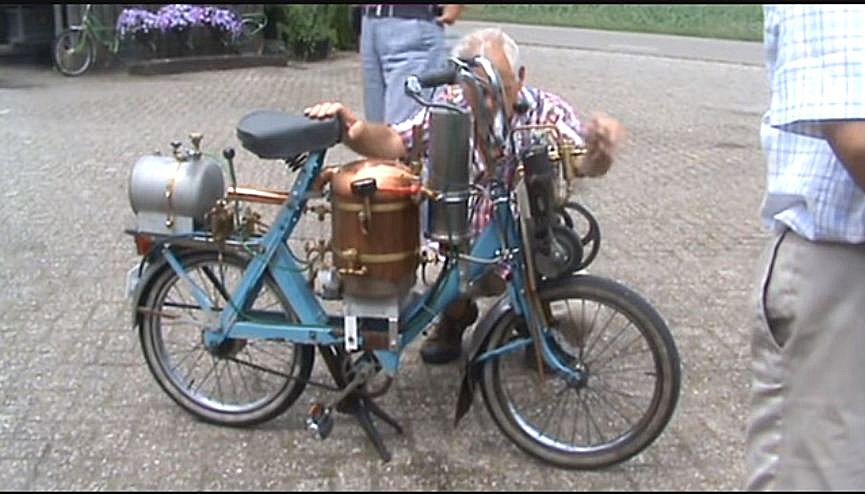 |
| Left: Steam-powered bike 2009
This steam bicycle was built by J Melchers- or at any rate that's the name on the YouTube video (uploaded July 2011)
There is a single-cylinder engine mounted over the front wheel, driving it by friction. The fuel is propane. A steam-whistle is fitted.
It is not very clear where the bike comes from but I think probably Belgium or Holland.
|

THE MARCO HAVALE STEAMBIKE: 2010
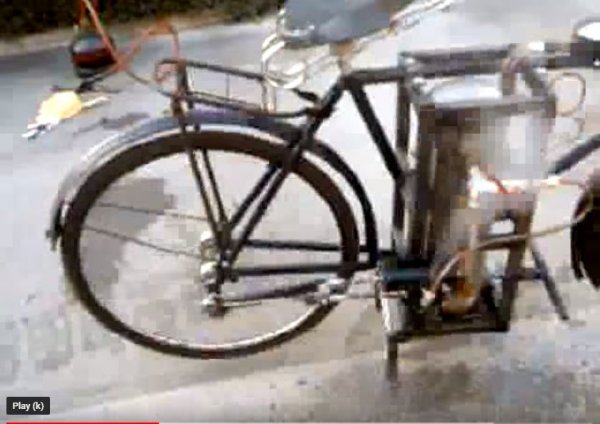 |
| Left: The Marco Havale steambike 2010
The steambike of Marco Havale can be seen on static steam-up test on YouTube. There is a single cylinder driving the rear axle directly, the valves being driven by a return crank on the outside of the main crank. No other details are known
Marco Havale is a steam enthusiast from Slovenia and a Steam Car Club of Great Britain member. Google has no further info on him.
Uploaded to YouTube Nov 2010, accessed Feb 2019.
|

THE RICHARD J SMITH STEAM BICYCLE: 2011
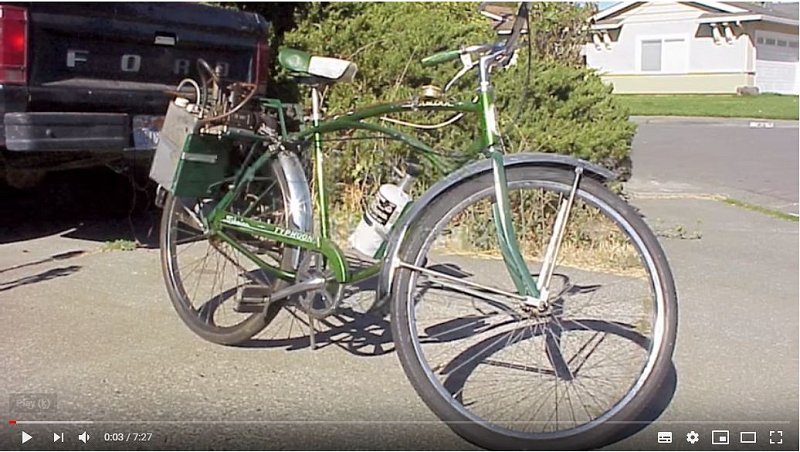 |
| Left: The Richard J Smith Steam-powered bike: 2012
This steam bicycle was built by Richard J Smith; it is currently owned by Robert Hopkins.
Here is a video on YouTube (uploaded July 2011)
It is powered by a two-cylinder Stuart Sirius engine.
|


A GERMAN STEAMBIKE: 2013
 |
| Left: Steam Powered Motorcycle: 2013
This very neat steam bicycle was presented at the 10th International Steam Meeting 2013 at the AGRONEUM Museum at Alt Schwerin. Alt Schwerin is a municipality in northern Germany. 'Dampftreffen' means 'steaming meeting'.
Here is a YouTube video. I have not been able to make out the name of the inventor from the German sound-track, but 'George nr one' appears on the screen toward the end; if anyone can help I will be glad to acknowledge the constructor. I would also be glad if anyone can tell me about any technical details revealed in the narration.
There is a two-cylinder steam engine mounted over the front wheel. It drives this via a wooden friction roller on the tyre, which pressure provided by a tension spring. How well this works in wet weather is not known. A steam whistle is fitted.
Some more technical details have been extracted from the video by Bernd F, to whom much thanks:
- The frame is a 1960's "Diamant" gentleman's bicycle, restored from scrap Diamant was East Germany's up-market bicycle brand.
- Construction began in May 2013
- As seen it is unfinished, with no feedwater pump and lacking the water tank which will go on the rear luggage rack
- The fuel is gasoline (the German word is Benzin)
- The engine has two cylinders of 28mm bore.
- Valve gear Flachschieber, which I think means a flat slide valve
- The friction roller drive on the front wheel allows the original pedal drive to the rear wheel to be retained, and the steam engine can be easily removed.
- The boiler is of copper with 54 fire tubes; it holds 750ml of water and the operating pressure is 6 bar (87 psi)
There is a later YouTube video of the completed machine; see from 0:30 to 2:38. (uploaded 2013)
|

THE BENJAMIN NAVARRO STEAMBIKE: 2014
 |
| Left: Steam Powered Motorcycle by Benjamín Navarro: 2014
This impressive machine, shown here driving around under steam, was built by Benjamín Franklin Navarro in Colombia in 2014. The YouTube page is in Spanish, and I have found no way to make Google Translate grapple with it without cutting and pasting it line by line; but anyway there do not seem to be any technical details there.
There is a single horizontal cylinder driving the rear axle directly. It looks like a soundly designed steambike; I noted the effective cylinder drain cocks in use at 1:30. The bike has a steam-whistle (at 3:30) rather than a horn, which is an elegant touch.
Google has no other information on Benjamín Navarro or his steambike.
|


RENÉ VAN TUIL AND THE BLACK PEARL: 2014
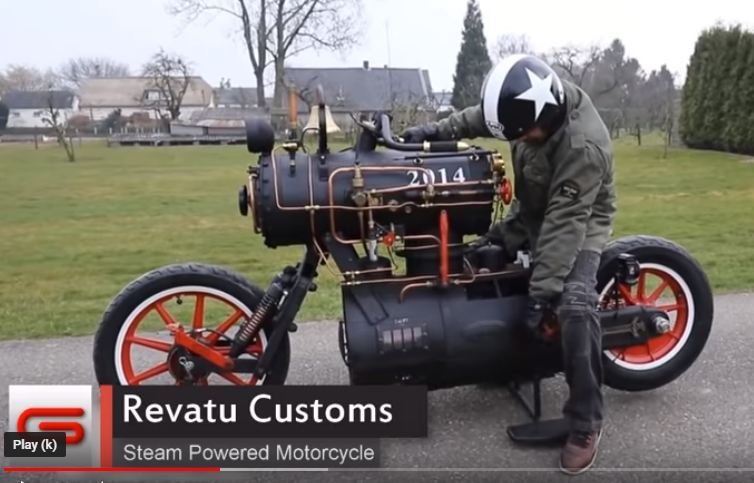 |
| Left: Steam Powered Motorcycle by René van Tuil: 2014
The Black Pearl is a truly remarkable steam-powered motorcycle created by Dutch bike builder René van Tuil, of Revatu Customs in Holland. There is a page on their site with many fine pictures of the Black Pearl; it is a wonderful construction strongly suggesting an unnatural coupling of an American locomotive and a motorbike. It was unveiled in 2014.
You can see it in action on YouTube from the 1.42 point, proceeding at a very stately 5 mph.
And yes, it is indeed named after Cap'n Jack Sparrow's much-troubled vessel.
|

THE KELTRUCK STEAM-BIKE-CHALLENGE: 2015
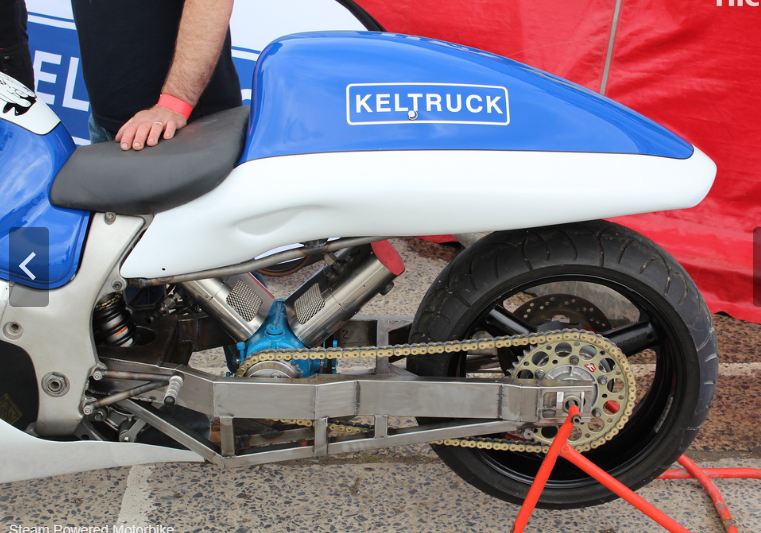 |
| Left: Steambike by Chris Wedgwood: 2015
The Keltruck company are sponsoring Chris Wedgwood and his team to develop this steambike to beat the steam land speed record. This record stood since 1906 when a Stanley steam car achieved 127 mph. It was finally broken in 2009 by a British steam turbine car which set a new record of 148 mph, which still stands today.
The basis of the bike is a Suzuki Hayabusa. The steam generator consists of a paraffin burner heating a coil of copper tubing filled with water. Steam conditions are said to be 950 degF and 2,000 psi The steam is fed to the Bower and Bell V-twin Compound Engine which from which there is direct chain final-drive to the rear wheel with no gearbox.
I was surprised that anyone was still manufacturing reciprocating steam engines; it appears that 'Bower and Bell' refers to a design rather than a company. In this forum someone says they 'bought the plans', while this forum says the design was published in Model Engineer. This link says the engine design dates from the 1930's.
The video shows the bike with steam up but not being ridden.
|

THE NORBERT MESSMER STEAMBIKE: 2016
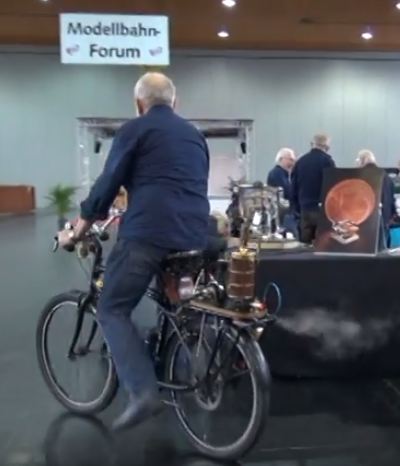 |
| Left: Steam powered bicycle by Norbert Messmer: 2016
This light steambike was built by Norbert Messmer. The power plant is a small vertical model engine fed from a model vertical boiler. The model engine is a Stuart 7A, mounted just ahead of the boiler. Bore and stroke are 1 inch.
The boiler is gas-fired; it does not appear to be a Stuart product. A steam-whistle is fitted.
The power output is obviously very limited but is sufficient to move the bike at a walking pace on the level.
Here is the machine pictured at a model engineering exhibition in Germany. (uploaded 2016)
And here is another short video, showing the engine running with the bike stationary.
|

THE HEMMELGARN STEAMBIKE: 2018
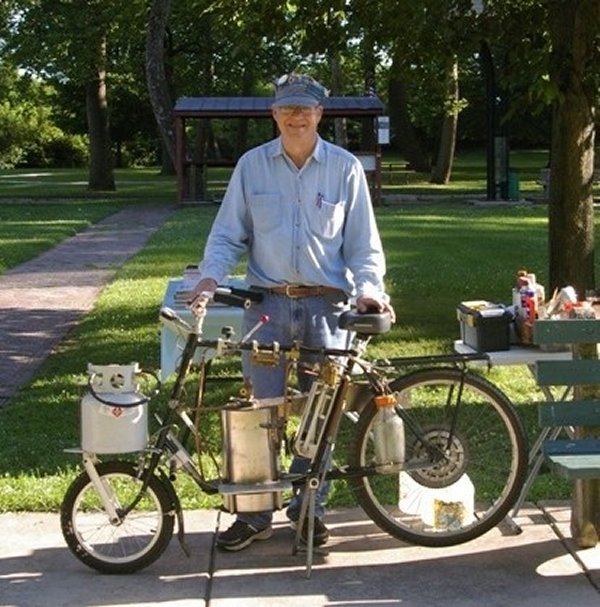 |
| Left: Steam Powered Motorcycle by Kenneth Hemmelgarn: 2018?
This impressive steambike was shown at the Dayton Mini Maker Faire, apparently in 2018.
No technical details are currently available.
|

MARK DRAKE'S STEAMBIKE: 2018
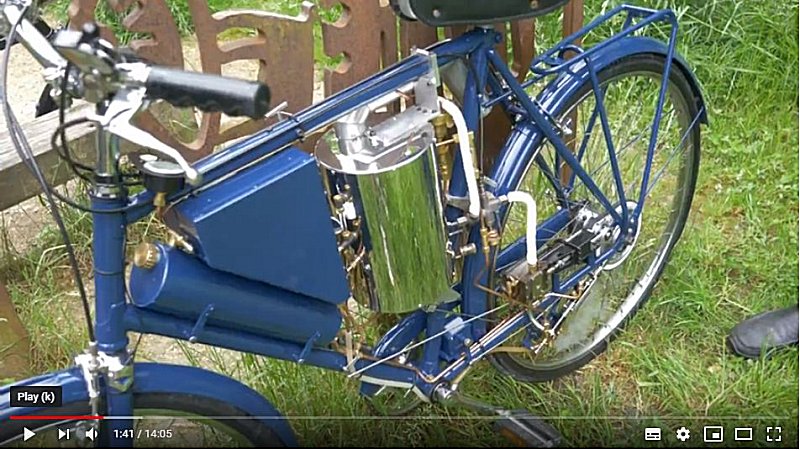 |
| Left: Steambike by Mark Drake 2018
In this video Mark Drake's 'Ruscombe Gentleman's Steam Bicycle' takes a trip through The Two Tunnels Greenway in Bath. This is the first time a steam vehicle been through the tunnels since 1966, when the route was closed by the infamous Beeching cuts which shut large sections of the UK's rail system.
One of the tunnels making up the Greenway is the single-track Combe Down Tunnel, which had a bad reputation for smoke and fumes as it had no intermediate ventilation shafts; it was once the UK’s longest tunnel without intermediate ventilation. This caused a serious accident in 1929, when the driver and fireman of a northbound goods train were overcome by the fumes.
On the steambike a single-cylinder engine drives the rear wheel through a pair of step-down spur gears. The rear axle drives a small pump.
There is another video and a bit more info here.
|

SIMON-PIERRE SMITH STEAMBIKE: 2019
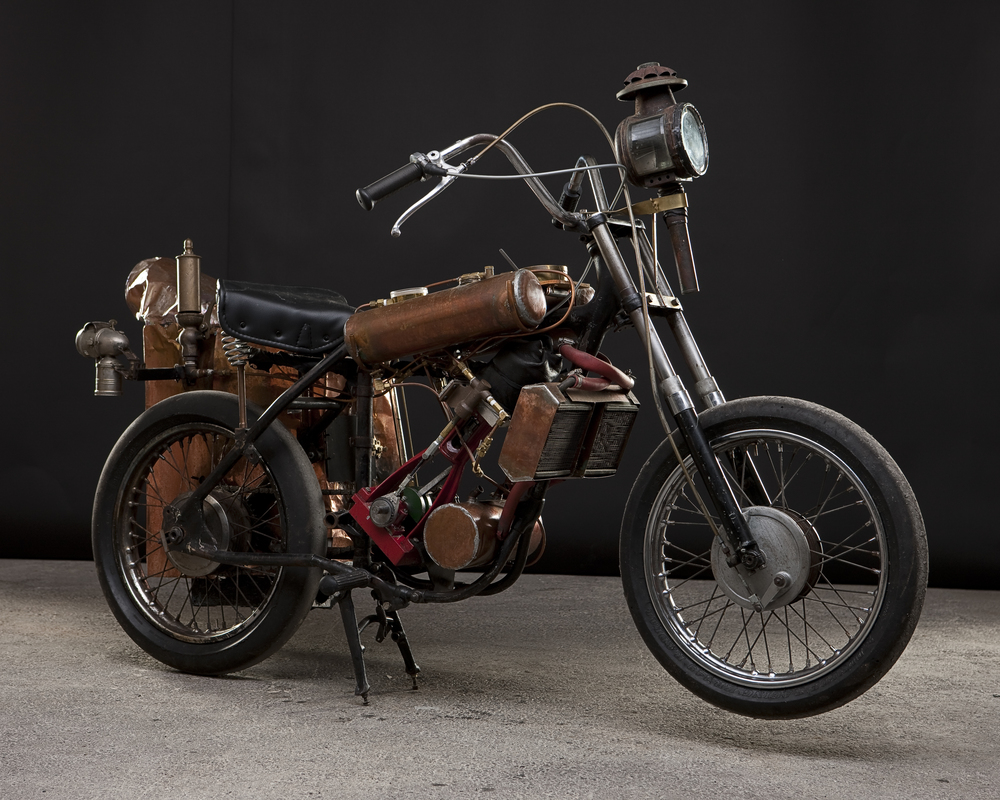 |
| Left: Steambike owned by Simon-Pierre Smith: 2019
This magnificent creation was shown at the One Motocycle Show in 2019.
The following technical details have been gathered from the One Motocycle Show website and by examination of the image:
| Frame | Probably BSA 250 “Starfire”
| | Engine | Single-cylinder double-acting
| | Valvegear | Eccentric-driven spool valve
| | Headlight | French carriage lantern (candle).
| | Tail-light | American carbide bicycle headlight,
lens “rouged” with dried red wine.
| | Whistle | Stationary plant whistle (huge)
| | Condensers | Triumph TR4 heater cores (two)
| | Boiler | Copper water tube, wood fired
| | Steam pressure | 120 PSI saturated (non-super-heated)
| | Top Speed | 25 MPH.
|
This steambike is unusual in that it has a condenser system; whether the twin condensers are adequate to the task at full throttle is unknown.
The boiler is the large copper box behind the rear wheel. Note the over-sized steam whistle just behind the saddle.
|

RUSSIAN STEAMBIKE: 2020
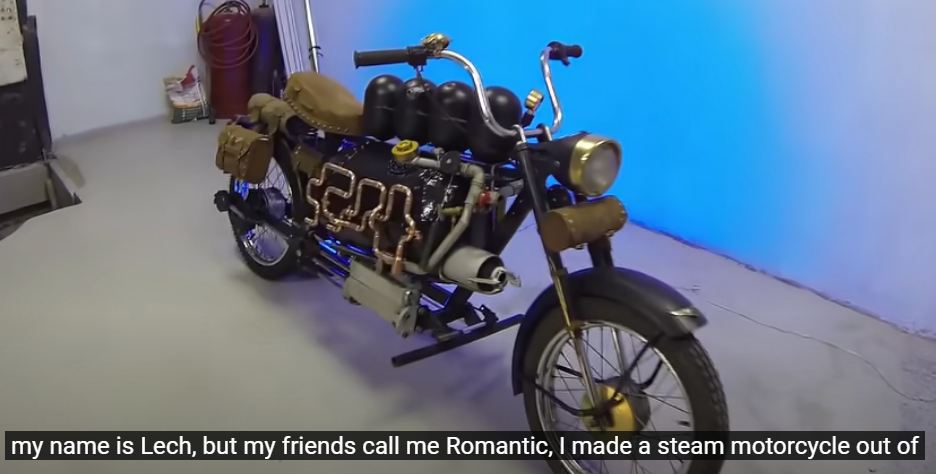 |
| Left: Russian steambike: 2020
This fine steambike was built from scrap parts in Russia. The boiler is the large black cylinder in the centre of the frame. Above it are four black fuel tanks that feed the burner. (possibly by gravity, but I think the fuel is probably propane) The single-cylinder engine is mounted horizontally below the boiler; it has a piston valve.
The grey cylinder sticking out of the front of the boiler is the burner.
It is not currently clear if the copper pipes on the side have any practical function; the arrangement looks too small to be any kind of condenser.
A YouTube video of this bike in operation is here. (Episode 8)
|
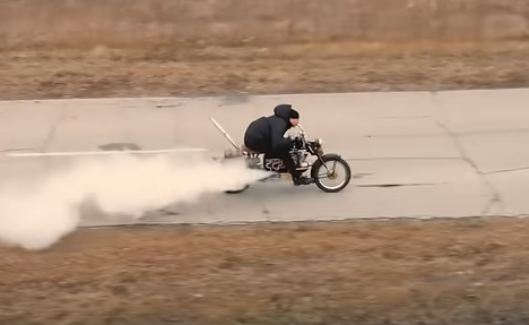 |
| Left: Russian steambike: 2020
This is a frame from the video mentioned above. There's no doubt that the steambike really works.
The pipe sticking up at the back is not an exhaust but a locomotive-type steam whistle.
I'd have worn a helmet myself, but well, this is Russia. NB This machine was added before the invasion of the Ukraine. I wouldn't add it now.
|

UNKNOWN STEAMBIKE: 20??
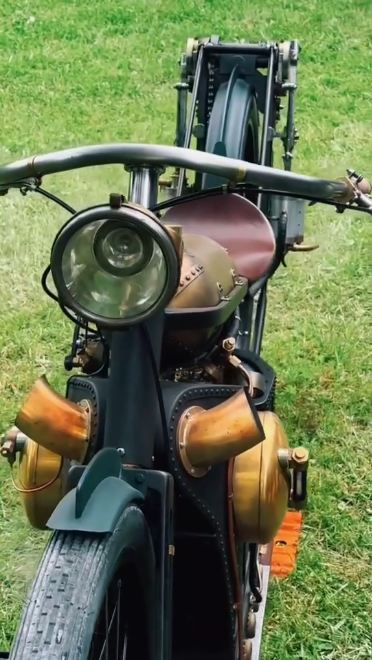 | 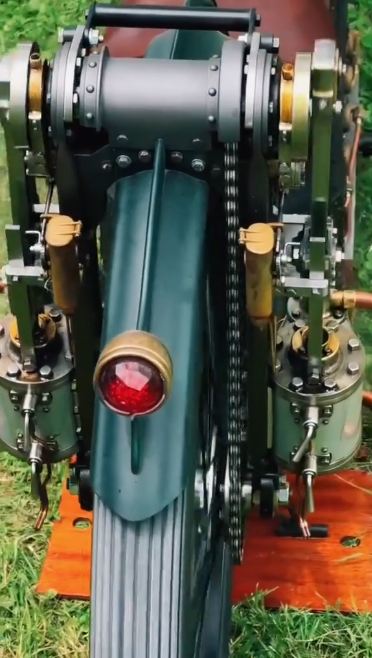 |
| Left: Unknown steambike: 20??
This is an absolutely wonderful machine; unfortunately nothing is known about it except for the existence of a video, with no sound track. Can anyone indentify it?
In the picture at far left can be seen the horizontal brass-coloured boiler with two curved exhaust pipes above it. There is a water-level gauge on the end of the boiler, angled so the rider can read it. The bronze fuel tank can be seen just to the right of the headlamp.
In the picture at left are the two double-acting steam cylinders that drive the rear wheel through a chain. The draincocks for the cylinders can be seen; the valve chests are on the other side of the cylinders. The two oval-shaped containers appear to be mechanical lubricators.
In the video the bike is seen running with the rear wheel propped up.
These images are from a video served up to me by Pinterest, I'm not sure if Pinterest links are volatile; I guess we'll soon find out.
|
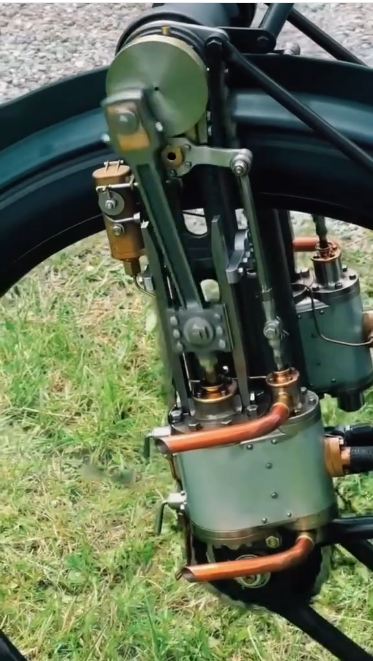 |
| Left: Unknown steambike: 20??
This shows one of the steam cylinders in the foreground. The valve chest is on the right, with two copper pipes for the steam exhaust. The valve spindle is driven by the lever just under the crankshaft disc. This lever is driven from the crankshaft by an eccentric; there seems to be no provision for changing the inlet valve cut-off or reversing the engine.
There is a steam-powered boiler feed pump (seen in the video) somewhere on the machine but its exact location is unclear.
|

FICTIONAL STEAMBIKES
As noted at the start of this page, the Steam Bike is an iconic Steampunk form of transport, second only to steam-powered airships. A Google image search on 'steambike' conjures up a huge number of baroque machines, though naturally most of them are models or CGI renderings.
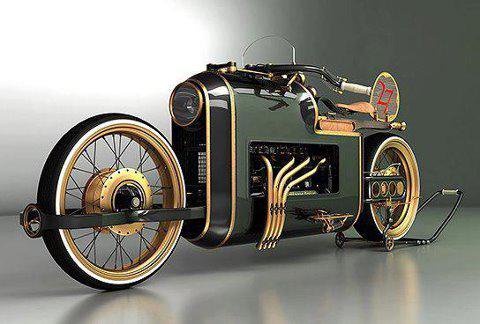 |
| Left: Steambike image: accessed Jan 2019
This is (I think) just a rendering, but it is beautifully done. I have now been told it is by Mikhail Smolyanov.
This machine is definitely labelled as a steambike, though those pipes look rather like the exhausts from a 4-cylinder in-line engine. Perhaps they are generously-sized cylinder drains?
I have no idea how the steering is supposed to work. Possibly it has Hub-center steering, but how does the front wheel swivel between those two horizontal support arms?
|
There are several steampunk songs that feature steambikes. My favourite is The Copper War by a band called 'The Cog is Dead'. The opening line is:
"Verdigris, Patina, was a peaceful little town..."
Which I think is simply brilliant. The chorus goes:
"So saddle up your steam-bike and put your goggles on
We've got to be prepared or else we'll all be dead by dawn!"
I'm not sure if strictly speaking you 'saddle-up' a steambike; I would have thought it should be 'fire up'. But never mind.































































